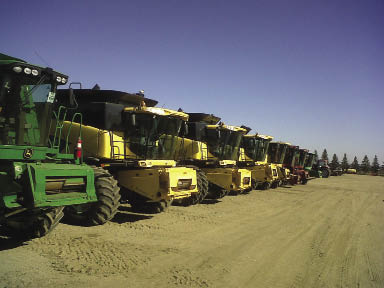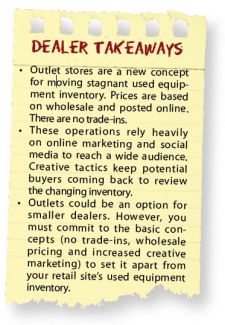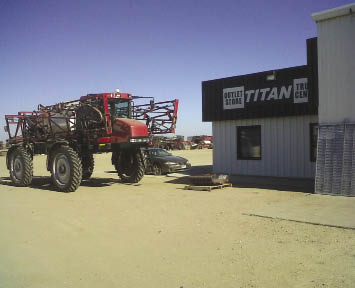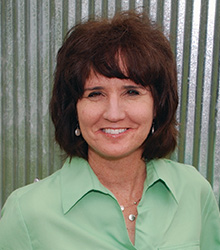A host of factors are forcing dealers to be more astute and innovative in handling trades and moving used inventory.
Trade-ins have always been a way of life in the farm equipment business, but moving used equipment taken in trades off dealer lots has taken on new urgency.
Changing economics, shifting markets, seasonal demand, adverse weather and other industry dynamics frequently work against dealers in their efforts to keep used equipment moving. More and more, the financial impact of trades that don't sell is often the difference between profit and loss. The longer used equipment stays on a dealer's lot, the more critical the impact.

The issue is a big one, and magnified for a company the size of Titan Machinery. With 90 retail stores in 8 states, keeping trade-ins of both ag and construction equipment moving takes some innovative thinking.
"Aged inventory can severely affect a store. Every time the market changes or a new model comes out or adverse weather affects a region, the value of the trade-in is impacted," says Don Aberle. He's part of a team that heads up one of Titan's answers to the used-equipment challenge — the Titan Outlet Store (www.titanoutletstore.com | Titan Outlet Profile).
According to Aberle, 5 to 15% of a dealer's business results in an undesirable trade situation. The problem trades need to be identified and remedied promptly, so the store can move past the problem and focus their efforts on "good" margin business.
The Outlet Approach
Here's how the concept works: Ag equipment moves from the retail stores to the two outlet locations based on days in inventory and regardless of type or brand of equipment or condition. The prices are based on cost and posted online, so customers know what the final price is.
The Outlet Store's purpose is to help Titan's retail stores manage used equipment inventory. There are other benefits, too.
"It allows our stores to be aggressive in gaining market share, knowing there's a backup to keep their used inventory fresh," Aberle says. "The Outlet Store also helps Titan reach categories of buyers we possibly were not selling to previously via traditional farm visits performed by our field marketers."
For the company overall, it creates a disciplined "trigger-point" in which the used equipment must move. This creates more discipline at the store level beginning the day a used unit is taken in, resulting in fewer days in inventory and accelerated used turns.
Planning for Used Machines
Aberle says Titan's leadership team came up with the idea in 2006 as part of ongoing efforts to keep used equipment moving.
"We have a perpetual, self-correcting, used inventory management process. Our executives spend a lot of time understanding the balance sheet to minimize potential risk while driving the revenue side of the business," Aberle says.
The first outlet location was in Moorhead, Minn., adjacent to the existing retail store and near the company's headquarters in West Fargo, N.D. The second location in Cherokee, Iowa, opened in 2007 and will relocate to Sioux City, Iowa, next year.
"Our executive team took an idea that works for other industries and put it to use for us," Aberle says. "Stores were skeptical at first. Most of them want to take care of their own used equipment that became aged inventory for various reasons and were reluctant to make the tough inventory decisions."
Aberle, a past field marketer, knows the challenges the sales team faces.
"Aged inventory is just a reality," he says, and emphasizes that a dealership must be aggressive with sales for continued growth. The Titan Outlet Store is a resource that allows them to do that, while still providing a wholesale solution for the problem used equipment.
"You need a plan to deal with used equipment. That's just good business," he says. Dealerships that let used inventory get away from them are eventually impacted financially.
There is a customer segment that only buys from a perceived auction/wholesale environment. An outlet store, with its one low price, no-trade philosophy fits this group of customers, says Aberle. Titan's wide spectrum of products, including hard-to-find specialized equipment, attracts buyers from across North America in addition to increased interest internationally.
All Titan Outlet Store inventory is available to end users, such as farmers, "jockeys," dealers and even Titan Machinery's own dealerships.
"Our reputation of serviced, clean equipment and out-of-the-box marketing has helped with equipment turn velocity," Aberle says.
The 'Re-Marketing' Process
Each month, Titan's administrative support center, which it refers to as the Shared Resource Center (SRC), generates a "re-marketing" list. This is equipment that will move to the outlet based on days in inventory, as well as a proposed list for the next month.
"Everybody sees it because we're all part of the same company," Aberle says. "The list keeps those who are affected by used inventory focused on retailing aged inventory. You never forget about your trade-in knowing there will be a day of reckoning when it will go to the Outlet Store."
There are different target dates based on days in inventory and whether the equipment is seasonal or not.
"It's not subjective, and we have a very disciplined system. That's why it works," Aberle says.
Historically, all dealerships have experienced an array of excuses, such as too much rain, not enough rain, commodity prices, wrong season, economy, etc. for the build-up of used equipment. If a used unit hasn't moved in that 6-to-9 month time frame, chances are it will be on the lot at 12 months, says Aberle. The Outlet Store takes away all the excuses.
After the equipment has been targeted, the first step is to move the contact information to the Titan Outlet Store, where its final price is posted online. Then, the Outlet Store logistics team coordinates with the retail store and trucking companies to transfer the equipment to the Moorhead or Cherokee outlets, depending on the store's location. An important concept that makes the Outlet Store successful is that the equipment is physically moved. They try to save costs with backhaul arrangements whenever possible.
How far would a piece of equipment travel? "From one end of Nebraska, Iowa, South Dakota, North Dakota or Minnesota to the other; or, for example, all the way from Pierre, S.D., to Moorhead, Minn.," Aberle says, indicating equipment can travel up to 350 miles.
They try to have the equipment physically transferred within two to three weeks.
Keep Inventory Moving
The outlet concept only succeeds if inventory moves every month, says Aberle. While a retail store may have 30-40 pieces of used equipment on its lot, the two Titan Outlet stores may have 200-250 pieces of equipment. The two outlet locations, with the help of the other stores, will move 900-1,000 units a year.
"We don't come in in the morning and hope for a call. We don't have a day where it doesn't let up," he says. "Knowing you have 25-30 days for the next monthly re-marketing move helps keeps the main objective first and foremost in one's mind daily: Get the equipment moved."
"What makes the Outlet Store successful is that the equipment is physically moved … "
— Don Aberle, Titan Outlet Store
Hear more from Don's interview here

The outlet store team includes 14 people combined at the two locations -- logistics experts, administrators, web and social media specialists and field marketers. Outreach is mostly Internet-based, with field marketers talking with customers by phone or online. They don't drive to the countryside to meet with farmers, but instead focus on closing.
"By and large, we don't market locally," he says. This allows the outlet team to focus on opportunities to reach new buyers, while regional customers work through their local store.
"Seventy-five to 80% of buyers are from the Internet."
The Marketing Formula
Titan Outlet relies on a mix of online marketing strategies, including its web site, YouTube, Facebook, Twitter, blogs, e-newsletters, print advertisements and more.
Each piece of equipment is displayed with photos, links to videos, detailed descriptions and the price. Aberle says videos have been especially helpful in shortening the sales process.
"They don't have to call you up and ask if it works. They've seen it being driven, or turning and working. We go overboard to provide as much information as possible," he says. They may show 20 photos along with a video. Dealerships in the past may have only shown four or five photos with limited detailed information and no video.
"The retail store's field marketer builds a relationship with the buyer via farm visits, becoming their ag equipment consultant. The Titan Outlet Store relationship-building process is different," says Aberle. "We solve a particular need at that moment and do our best to make sure they come back the next time they have a need. Someone comes to us because they're looking for something in particular, not because they want a new tractor with the latest features."
Social media has been critical to reaching buyers. Aberle credits it with increasing visits to the outlet web site by 25-30%. The Facebook page boasts more than 18,000 people who have "liked" their page, which means they receive Titan updates in their stream of information.
Creativity and customer incentives coax people into checking inventory often. A recent Facebook contest offered a free cruise. Twitter posts include scavenger hunts, like this one, with a $50 cash prize:

Titan Outlet Inventory Search clue #1: Just in time for football season, one of my features is a kicker. (The answer: a baler.)
"We can never reach enough people. Eighty percent of regular retail sales are made with trade-ins. We don't do trade-ins, so that means we can't reach 80% of the market," he says. "We need to reach 100-150 people to make a sale. A dealer may only need to call on 5 people that day to make a sale."
They also post twice a week to their blog. The blog is about information, not opinions. Recent posts included such topics as accountability and grain storage. Of course, they also talk about equipment, but are careful not to make every post a sales pitch.
Titan Outlet also integrates traditional print advertising to take advantage of seasonal demand, increasing frequency in the March/April, July/August and end-of-year time frames. Word-of-mouth is also still important.
"We need neighbors telling neighbors," says Aberle.
Overcoming Purchase Obstacles
Like any new concept, Aberle says the outlet must continue to educate and remove purchase obstacles.
"Customers still don't understand the concept of wholesale pricing and the role the Outlet Store provides for Titan Machinery overall. It may take 5 more years for people to understand that approach," says Aberle.
He says the Outlet Store margins are often zero or may even show a loss.
"Our job is to keep our equity together," Aberle says.
He knows buyers may be thinking, "Why is it so cheap?" or "What's wrong with it?" He says they offer the same policies as any dealership, including financing options.
They also offer a free, online classified service to offset the no-trade in policy. It's not just for customers, either. Sellers provide photos and descriptions and the outlet team posts them on the Outlet Store site. Interested buyers contact the seller directly. There is no time limit on how long equipment remains on the classified list.
Retail Store Relationship
Aberle says Titan Outlet does have an unusual role in the company because of its impact on retail stores.

The Outlet Store's purpose is to help Titan's retail stores manage used equipment inventory. It allows the stores to be aggressive in gaining market share, knowing there's a back-up to keep their used inventory fresh.
"When their used equipment comes to us, it hurts them," he says. Stores lose potential revenue from a used equipment sale and possibly some reconditioning costs. Not going to Outlet is an added incentive for stores to use proactive "best-in-class" used equipment practices.
"We know it's working for the company because we're turning used equipment into cash. For the dealer, I think they're glad the equipment is gone."
Duplicating the Outlet Concept
Could this outlet concept work for other dealerships? Aberle says it could, and he believes other successful dealerships will adopt it into their operating model. He offers this advice:
An outlet is a different way of doing business.Make a commitment to the concept.Don't bend the rules.Be prepared to make the extra effort to sell, since there are no trade-ins.
"The challenge is finding that potential buyer knowing we do not do trades. The positives are our wholesale pricing philosophy. It's why I love my job," says Aberle.







Post a comment
Report Abusive Comment